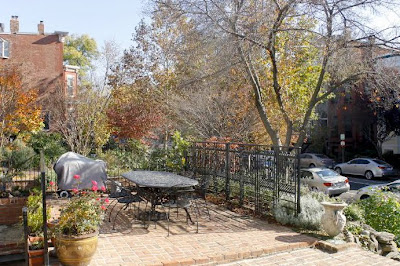

Washington D.C.'s fast-growing 14th Street corridor between Thomas Circle and Florida Avenue may finally get some much-deserved street-scaping improvements soon, says John Lisle of the District Department of Transportation.
Plans that have been in the works since 2009 may get accelerated after DDOT commences on a similar street-scaping project for U Street later this year, Lisle told DCMud. The 14th Street design, which wrapped up last April at a cost of $450,000, includes iconic "twin-20" Washington Globe lighting along pedestrian walkways and "teardrop" pendant lighting for street illumination.
Included will be dedicated bike lines and pedestrian "bulb-outs" for safety. At key intersections, such as Rhode Island Avenue, Florida Avenue and U Street, crosswalks and sidewalks will get special iconic identification. Cracked cement sidewalks will give way to London pavers, similar to those required in the Downtown DC Business Improvement District. New street furniture such as garbage bins, tree boxes and bike racks are also in the works for the 14th Street upgrade.

 Already, parts of 14th Street in the downtown area have gotten similar treatment. The District was able to use $3.6 million in federal Recovery Act funds in 2009 and 2010 for improved street lighting and sidewalks for a stretch of 14th Street between K Street and Thomas Circle, which got its own facelift. A stretch of 11th Street between Massachusetts and O got its own similar upgrade in 2009.
Already, parts of 14th Street in the downtown area have gotten similar treatment. The District was able to use $3.6 million in federal Recovery Act funds in 2009 and 2010 for improved street lighting and sidewalks for a stretch of 14th Street between K Street and Thomas Circle, which got its own facelift. A stretch of 11th Street between Massachusetts and O got its own similar upgrade in 2009.Lisle says that the city has focused on completing its "Great Streets" programs first before tackling major upgrades of other corridors. The "Great Streets" program, started in 2005 by then Mayor Anthony Williams, is working in conjunction with the Office of the Deputy Mayor for Planning and Economic Development to jump-start retail and development on long-dormant corridors that have historically been gateways to the city, such as H Street, Pennsylvania Avenue and Georgia Avenue.
The H Street "Great Streets" corridor has just completed, and includes tracks for the District's trolley car plans, while the $3.6 million Georgia Avenue "Great Streets" project is also nearing completion. Pennsylvania Avenue's Great Streets construction, running from 27th Street to Southern Ave, will finish next month at a cost of more than $25 million in federal Recovery Act money. The District has also used $4.5 million in federal funds to rehab stretches of 17th Street, NW with similar lighting upgrades and street furniture, as well as a project on 18th Street in Adams Morgan to improve lighting and pedestrian access, scheduled for completion in May.
The 14th Street Logan Circle corridor has been ground zero for the District's inner core revitalization. Whole Foods, between 14th Street and 15th Street on P Street, which opened in 2000, now anchors the corridor.
Washington D.C. real estate development news
Washington D.C. real estate development news

















 The $2 billion, 2.5 million-square-foot project, dubbed “The Wharf,” takes its cues from
The $2 billion, 2.5 million-square-foot project, dubbed “The Wharf,” takes its cues from 





 Union Station's grand Main Hall, amid all the construction netting and scaffolding resulting from the emergency ceiling repairs prompted by August's earthquake, you'd be hard pressed to spot preparation for two shafts set to penetrate the Main Hall's pink marble floor.
Union Station's grand Main Hall, amid all the construction netting and scaffolding resulting from the emergency ceiling repairs prompted by August's earthquake, you'd be hard pressed to spot preparation for two shafts set to penetrate the Main Hall's pink marble floor.
























